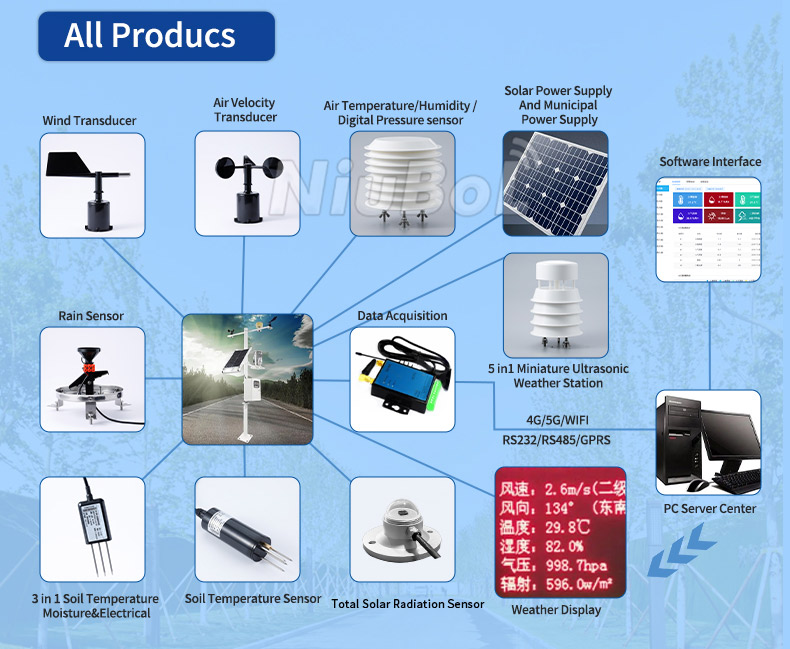

— Blogs —
—Products—
 Consumer hotline +8618073152920
Consumer hotline +8618073152920 WhatsApp:+8615367865107
Address:Room 102, District D, Houhu Industrial Park, Yuelu District, Changsha City, Hunan Province, China
Product knowledge
Time:2022-09-15 21:29:07 Popularity:527
The value of photosynthetically active radiation sensor in agricultural and horticultural research
Photosynthetically active radiation (400-700 nm) is the most important environmental element for plant growth. In facility agriculture or horticulture research, the optimal light intensity and duration of light should be determined according to the plant species and its growth period.
For example, plants generally require more and stronger light during vegetative and reproductive growth stages than during seed setting and harvesting. Therefore, in facility agriculture or horticulture, rational regulation of photosynthetically active radiation can not only effectively save light and electricity, but also promote yield improvement.
In a greenhouse or incubator, proper light control is very important. For example, through the control of photoperiod, the artificial regulation of flowering time of long-day and short-day plants (long-day plants such as carnations and short-day plants such as poinsettia) can be realized to optimize photosynthesis to the greatest extent.

In addition, artificial light supplementation is also a current research hotspot. When natural light is insufficient, using artificial light sources to supplement light for greenhouse crops can usually increase their dry matter yield. However, the knowledge inside is not small. For example, what light quality to use to fill? What is the effect of different light qualities on crop yield and quality? How long to make up? Is it supplemented all day long, or for a period of time? These issues require in-depth study.

For example, studies have shown that CL-induced Injury usually occurs if continuous light is applied all day long. Tomatoes, in particular, are very sensitive to this kind of continuous light. Researchers such as Ryo Matsuda from the School of Agriculture and Life Sciences, University of Tokyo found that the spectrum and light intensity used for nighttime supplemental light vary greatly on tomato seedling growth and leaf damage.

Photosynthetically Active Radiation Sensor
Product introduction of photosynthetically active radiation sensor:
Photosynthetically active pyranometer, also known as photon number, is mainly used to measure the photosynthetically active radiation of natural light in the wavelength range of 400-700nm. The table uses a silicon photodetector and passes through a 400-700nm optical filter.
When there is light irradiation, a voltage signal proportional to the intensity of incident radiation is generated, and its sensitivity is proportional to the cosine of the direct angle of the incident light. Each photosynthetically active pyranometer gives its own sensitivity and can be read directly. The unit is µmol/㎡•s. This table is widely used in agricultural meteorology and crop growth research.
Prev:Advantages, characteristics and functions of photovoltaic weather stations
Next:Farmland climate observation station is an inevitable choice for agricultural development at present
Related recommendations
Sensors & Weather Stations Catalog
Agriculture Sensors and Weather Stations Catalog-NiuBoL.pdf
Weather Stations Catalog-NiuBoL.pdf
Related products
 Combined air temperature and relative humidity sensor
Combined air temperature and relative humidity sensor Soil Moisture Temperature sensor for irrigation
Soil Moisture Temperature sensor for irrigation Soil pH sensor RS485 soil Testing instrument soil ph meter for agriculture
Soil pH sensor RS485 soil Testing instrument soil ph meter for agriculture Wind Speed sensor Output Modbus/RS485/Analog/0-5V/4-20mA
Wind Speed sensor Output Modbus/RS485/Analog/0-5V/4-20mA Tipping bucket rain gauge for weather monitoring auto rainfall sensor RS485/Outdoor/stainless steel
Tipping bucket rain gauge for weather monitoring auto rainfall sensor RS485/Outdoor/stainless steel Pyranometer Solar Radiation Sensor 4-20mA/RS485
Pyranometer Solar Radiation Sensor 4-20mA/RS485
Screenshot, WhatsApp to identify the QR code
WhatsApp number:+8615367865107
(Click on WhatsApp to copy and add friends)